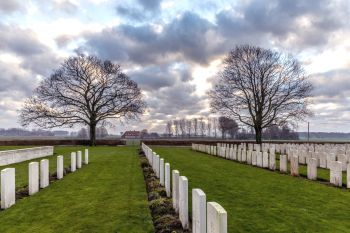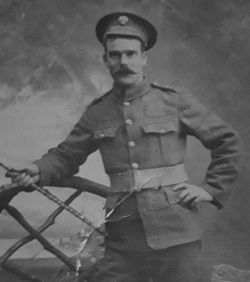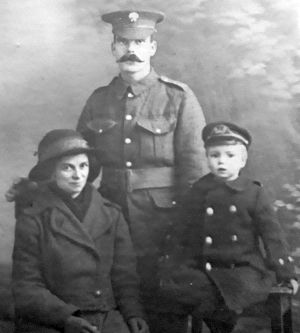|
|
| Home Topics Memorials Miscellany Transcripts References Family History Glossary Latest Beeston Blog About us | Site Search |
|
In October 1904, John Samuel enlisted in the Army on a short service engagement of three years with a commitment of 9 years in the Reserve. After serving the three years with 3rd Battalion Grenadier Guards, he transferred to the Reserve and returned to civilian life in Beeston, in October 19075. By 1911, he and his surviving siblings were all living at 40 Upper Regent Street, Beeston with the eldest, Mary Harriett, as the notional head of the family. John Samuel was then aged 24 and was working as a moulder and foundry labourer6. In July 1913, John married Rose Hannah (or Rosanna) Perks7 who had been working in Beeston as a domestic servant for the family of Owen Sutton, the butcher who lived and traded at 51 Wollaton Road, Beeston. Their son, John Turton was born in December 19138. As an Army Reservist, John Samuel was recalled to active service when Britain declared war on 4 August 1914. Mobilisation began immediately and Private Turton left Chelsea Barracks with 2nd Battalion Grenadier Guards and arrived at Le Havre, France on 15 August as part of the 4th (Guards) Brigade of the 2nd Division, a component of the British Expeditionary Force9. The Division was soon engaged in several of the actions on the Western Front. At the First Battle of Ypres in October/November 1914, the battalion suffered huge casualties, such that only 4 officers and 140 men remained, although contingents of reinforcements continued to arrive to replace the losses. On 23 October 1914 John Samuel was one of those injured, suffering a shell wound to his back. After treatment in the field, he was returned to England for further treatment and recuperation10. In August 1915, the battalion was transferred to the 1st Guards Brigade of the Guards Division and by November of that year, John Samuel had been posted to France once more, at first with 2nd Battalion but then, for about six weeks, attached to Entrenching Battalions. 3rd Battalion which had arrived in France in July and became part of the 2nd Guards Brigade and John Samuel was later transferred to that Brigade. However, as the two battalions were involved in much the same actions throughout 1916 and 1917, surviving records of one, largely apply to the other. Interestingly, 2nd battalion was joined at the front on November 20 1915 by Winston Churchill who had recently resigned from the Government and taken the rank of Major11.
Private Turton embarked for France on 19 January 1917 and joined 3rd Battalion at the front on 10th February. Winter mud, rain and snow presented desperately difficult conditions with only occasional action. However, German forces were planning a withdrawal to new positions on the shorter, more easily defended Hindenburg Line, about 25 miles narrower and to the rear of their previously held position. During fighting in February and March 1917 - which involved both Guards battalions - the withdrawal was successfully carried out and British patrols probing German outposts found them unoccupied. In preparation for the withdrawal, the enemy had destroyed the abandoned area - railways and roads had been dug up, trees felled, water wells polluted, towns and villages destroyed and a large number of mines and other booby-traps had been planted. This destruction and a well-prepared rear-guard, slowed the possibility of immediate follow-up and allowed the withdrawal to be completed in an orderly way. When it was complete, the British found themselves facing a far more formidable German defensive position than they had after the Somme battles, as the enemy once again occupied all the higher and more strategically important positions, overlooking lower ground on which the Allies had to dig in and attack from during subsequent actions in the area. In the summer of the 1917, a series of battles which together made up the Third Battle of Ypres began with the Battle of Pilkern in which the Guards battalions were involved. After this finished on the 2nd August, 3rd Battalion, along with others were billeted in camps in the Ypres salient involved in preparation work for future actions. On 4 September, the battalion moved to Eton Camp which was tented and close to the railway and as a consequence there was considerable bombing by hostile aircraft and there were 40 casualties13. It is likely that, after surviving over three terrible years of action, Private Turton was one of those who were wounded. He died of his wounds on 12 August despite the best efforts of the staff of the dressing station situated in a nearby farmhouse at Canada Farm. Private Turton was buried in Canada Farm Cemetery which is located 8.5 kilometres north-west of Ypres. It took its name from the farmhouse used as a dressing station during the 1917 Allied offensive on this front. Most of the burials are of men who, like Private Turton, died at the dressing station, between June and October 1917. There are 907 First World War burials in the cemetery. Private Turton was posthumously awarded the 1914 Star, the British War Medal and the Victory Medal14. Rose, his widow was paid his financial effects of £14 3s 7d, on behalf of herself and their son John, in two installments on 29 January 1918 and 25 February 1918, She also received his War Gratuity of £18 on 28 September 191915. At the end of the war, Rose was living at 4 Alexandra Cottages, Villa Street, Beeston and, for a short time, took a job at Beeston Foundry. She later moved to 16 City Road, Beeston16. She died in 1970, aged 8417. John's elder brother, Thomas William Turton, served with the South Staffordshire Regiment and died of wounds on 31 May 1918. Footnotes 1The photograph of the Canada Farm Cemetery is from the Commonwealth War Graves Commission website. (http://www.cwgc.org) 2His birth was registered in Nottingham Registration District (of which Lenton was part) in Q1/1887 (Ref 7b 243). Although his name was registered as 'John Samuel', his name is sometimes stated as 'John Sidney' on later records. 31901 Census, Piece 3153 Folio 11 41901 Census, Piece 3208 Folio 19 5Details from his Reserve Certificate which survives within the family. He declared his age at enlistment as 18 years 10 months, apparently inflating his real age by one year. 61911 Census, Piece 20431 RD429 SD3 ED6 Sched 327 7The marriage took place at Basford Register Office on 26 July 1913 and was registered in Basford Registration District in Q3/1913 (Ref 7b 522) 8The birth on 22 December 1913 was registered in Basford Registration District (of which Beeston was part) in Q1/1914 (Ref 7b 522) 9Details of the deployment of 2nd and 3rd Battalions of the Grenadier Guards are from the Forces War Records website (www.forces-war-records.co.uk/units/347/grenadier-guards). John's early attachment to 2nd Battalion is based on his medal card on which this is recorded along with his embarkation date of 13 August 1914. 10Details of his wound, treatment and return to France are from a summary of his Service Record which is held by his family. The original is presumably with the Guards records which are not part of the Service Records held at ancestry.com. 11This is recorded in the battalion war diary on that date. A transcript of the diary is at https://3rdgrenadierguardsww1.wordpress.com. 12Details of his wound, treatment and return to France are again from a summary of his Service Record which is held by his family. 13Based on entries in 3rd Battalion's war Diary. 14Details from John's Medal Card and Medal Rolls - available on ancestry.com. 15Details of the payments are from the "Army Register of Soldiers' Effects, 1901-1929" - available on ancestry.com. The amount of the gratuity tends to confirm Richard's enlistment date of August 1914. 16The Alexandra Cottages, Beeston address is included in John's CWGC documentation and the 1921 Electoral Roll. Rose is recorded at the City Road address in the 1930 Electoral Roll. 17For some reason, she died in Newark Registration District in Q1/1970 (Ref 3c 745). She was cremated, probably at Wilford Hill Crematorium, on 27 February 1970. |
|
|||||||||||
|
|
|||||||||||||

 Although all of his nine siblings were born in Beeston, John Samuel Turton was born in Lenton, Notts on 27 November 18872, the third child, second son of
John (b. 1864, Nottingham) and Mary Elizabeth (b. c1863, Beeston née Hazzledine). John worked in the lace trade as a warper and, in 1901, was living with
his wife and nine of their children at 4 Greyhound Yard, an area of poorer housing off the north side off High Road, adjacent to the inn of that name3. John
junior, then aged 14, was living at West Gate, Chilwell, Notts as a domestic servant to William Baker, a retired farmer and his wife Mary4. In the
next few years, tragedy hit the family when, first John died, aged under 40, in 1902, followed three years later by his widow, aged about 42. Two of their children
also died, Herbert in 1901 and Nellie in 1902, which left eight siblings to continue their lives together.
Although all of his nine siblings were born in Beeston, John Samuel Turton was born in Lenton, Notts on 27 November 18872, the third child, second son of
John (b. 1864, Nottingham) and Mary Elizabeth (b. c1863, Beeston née Hazzledine). John worked in the lace trade as a warper and, in 1901, was living with
his wife and nine of their children at 4 Greyhound Yard, an area of poorer housing off the north side off High Road, adjacent to the inn of that name3. John
junior, then aged 14, was living at West Gate, Chilwell, Notts as a domestic servant to William Baker, a retired farmer and his wife Mary4. In the
next few years, tragedy hit the family when, first John died, aged under 40, in 1902, followed three years later by his widow, aged about 42. Two of their children
also died, Herbert in 1901 and Nellie in 1902, which left eight siblings to continue their lives together. The Battle of the Somme had begun disastrously on July 1st with great loss of life, and this continued in actions throughout the remainder of the first phase in July and throughout August. It
was against this background that both battalions were assigned to the The Battle of Flers–Courcelette, the next phase of the Somme battle, which began on the 15th September 1916. Despite inevitable
casualties the action overall was a tactical success and in September as a whole, the German armies on the Somme lost about 130,000 casualties, bringing the German Empire closer to military collapse
than at any time before the autumn of 1918. The Battle of Morval, which was part of this period of Allied success had begun on the 25 September. During the battle, Private Turton was wounded by gunshot
to his left arm. After transfer to No 3 Stationary Hospital, Rouen, he was again returned to England for treatment12. It seems likely that it was at some point prior to his return to the Front, this time
with 3rd Battalion, that he was able to spend some time at home with his wife and son and when this photograph was taken.
The Battle of the Somme had begun disastrously on July 1st with great loss of life, and this continued in actions throughout the remainder of the first phase in July and throughout August. It
was against this background that both battalions were assigned to the The Battle of Flers–Courcelette, the next phase of the Somme battle, which began on the 15th September 1916. Despite inevitable
casualties the action overall was a tactical success and in September as a whole, the German armies on the Somme lost about 130,000 casualties, bringing the German Empire closer to military collapse
than at any time before the autumn of 1918. The Battle of Morval, which was part of this period of Allied success had begun on the 25 September. During the battle, Private Turton was wounded by gunshot
to his left arm. After transfer to No 3 Stationary Hospital, Rouen, he was again returned to England for treatment12. It seems likely that it was at some point prior to his return to the Front, this time
with 3rd Battalion, that he was able to spend some time at home with his wife and son and when this photograph was taken.